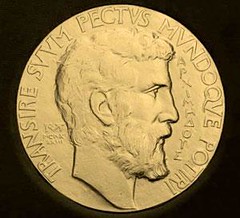
PREV ARTICLE
NEXT ARTICLE
FULL ISSUE
PREV FULL ISSUE
STANFORD PROFESSOR AWARDED FIELDS MEDAL
A Stanford University professor has become the latest winner of the Fields medal for mathematics, the first woman to be awarded the rare honor.
-Editor
Today, Mirzakhani — a 37-year-old mathematics professor at Stanford University — still writes elaborate stories in her mind. The high ambitions haven’t changed, but the protagonists have: They are hyperbolic surfaces, moduli spaces and dynamical systems. In a way, she said, mathematics research feels like writing a novel. “There are different characters, and you are getting to know them better,” she said. “Things evolve, and then you look back at a character, and it’s completely different from your first impression.” With her low voice and steady, gray-blue eyes, Mirzakhani projects an unwavering self-confidence. She has an equal tendency, however, toward humility. Asked to describe her contribution to a particular research problem, she laughed, hesitated and finally said: “To be honest, I don’t think I’ve had a very huge contribution.” And when an email arrived in February saying that she would receive what is widely regarded as the highest honor in mathematics — the Fields Medal, which was awarded August 13 at the International Congress of Mathematicians in Seoul, South Korea — she assumed that the account from which the email was sent had been hacked. Other mathematicians, however, describe Mirzakhani’s work in glowing terms. Her doctoral dissertation — about counting loops on surfaces that have “hyperbolic” geometry — was “truly spectacular,” said Alex Eskin, a mathematician at the University of Chicago who has collaborated with Mirzakhani. “It’s the kind of mathematics you immediately recognize belongs in a textbook.” To read the complete article, see: Meet the First Woman to Win Math’s Most Prestigious Prize (www.wired.com/2014/08/maryam-mirzakhani-fields-medal/)
Below is a little more information the medal and its namesake.
QUICK QUIZ: Who can name the Canadian sculptor of the medal? This must be one of his rarest pieces. Does anyone know if one has ever come to the market?
-Editor

The Fields Medal is often referred to as the mathematical equivalent of the Nobel Prize, but it is granted only every four years and is given, by tradition, to mathematicians under the age of 40, rather than to more senior scholars. The Fields Medal originated from surplus funds raised by John Charles Fields (1863–1932), a professor of mathematics at the University of Toronto, as organizer and president of the 1924 International Congress of Mathematicians in Toronto. The Committee of the International Congress had $2,700 left after printing the conference proceedings and voted to set aside $2,500 for the establishment of two medals to be awarded at later congresses. Following an endowment from Fields’s estate, the proposed awards—contrary to his explicit request—became known as the Fields Medals. The first two Fields Medals were awarded in 1936. An anonymous donation allowed the number of prize medals to increase starting in 1966. Medalists also receive a small (currently $1,500) cash award. A related award, the Rolf Nevanlinna Prize, has also been presented at each International Congress of Mathematicians since 1982. It is awarded to one young mathematician for work dealing with the mathematical aspects of information science.
To read the complete article, see:
Fields Medal
(www.britannica.com/EBchecked/topic/206375/Fields-Medal)
The Numismatic Bibliomania Society is a non-profit organization promoting numismatic literature. See our web site at coinbooks.org. To submit items for publication in The E-Sylum, write to the Editor at this address: whomren@gmail.com To subscribe go to: https://my.binhost.com/lists/listinfo/esylum All Rights Reserved. NBS Home Page Contact the NBS webmaster 
|
